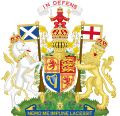Unicorn
Monocerus |

The unicorn is a legendary creature that has been described since antiquity as a beast with a single large, pointed, spiraling horn projecting from its forehead.
In European literature and art, the unicorn has for the last thousand years or so been depicted as a white horse-like or goat-like animal with a long straight horn with spiralling grooves, cloven hooves, and sometimes a goat's beard. In the Middle Ages and Renaissance, it was commonly described as an extremely wild woodland creature, a symbol of purity and grace, which could be captured only by a virgin. In encyclopedias, its horn was described as having the power to render poisoned water potable and to heal sickness. In medieval and Renaissance times, the tusk of the narwhal was sometimes sold as a unicorn horn.
A
The unicorn continues to hold a place in popular culture. It is often used as a symbol of fantasy or rarity.
History
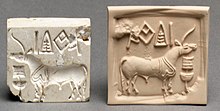
Indus Valley civilization
A creature with a single horn, conventionally called a unicorn, is the most common image on the
In South Asia, the unicorn is only seen during the IVC period, and disappeared in South Asian art after this. Jonathan Mark Kenoyer stated the IVC "unicorn" has no "direct connection" with later unicorn motifs observed in other parts of the world; nonetheless, it remains possible that the IVC unicorn had contributed to later myths of fantastical one-horned creatures in West Asia.[5]
Classical antiquity
Unicorns are not found in Greek mythology, but rather in the accounts of natural history, for Greek writers of natural history were convinced of the reality of unicorns, which they believed lived in India, a distant and fabulous realm for them. The earliest description is from Ctesias, who in his book Indika ("On India") described them as wild asses, fleet of foot, having a horn a cubit and a half (700 mm, 28 inches) in length, and colored white, red and black.[6] Unicorn meat was said to be too bitter to eat.[7]

Ctesias got his information while living in
Cosmas Indicopleustes, a merchant of Alexandria who lived in the 6th century, made a voyage to India and subsequently wrote works on cosmography. He gives a description of a unicorn based on four brass figures in the palace of the King of Ethiopia. He states, from report, that "it is impossible to take this ferocious beast alive; and that all its strength lies in its horn. When it finds itself pursued and in danger of capture, it throws itself from a precipice, and turns so aptly in falling, that it receives all the shock upon the horn, and so escapes safe and sound".[17][18]
Middle Ages and Renaissance

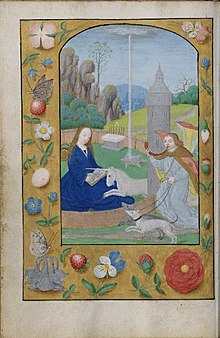

Medieval knowledge of unicorns stemmed from biblical and ancient sources, and unicorns were variously represented as a kind of wild ass, goat, or horse.
Several European medieval travelers claimed to have seen unicorns in their travels outside of Europe. For example Felix Fabri claimed to have seen a unicorn in Sinai.[19]
The predecessor of the medieval
The unicorn also figured in
However, when the unicorn appears in the medieval legend of
The unicorn, tamable only by a virgin woman, was well established in medieval lore by the time Marco Polo described them as "scarcely smaller than elephants. They have the hair of a buffalo and feet like an elephant's. They have a single large black horn in the middle of the forehead... They have a head like a wild boar's... They spend their time by preference wallowing in mud and slime. They are very ugly brutes to look at. They are not at all such as we describe them when we relate that they let themselves be captured by virgins, but clean contrary to our notions." It is clear that Marco Polo was describing a rhinoceros.[22]
Alicorn
The horn itself and the substance it was made of was called alicorn, and it was believed that the horn holds magical and medicinal properties. The
False alicorn powder, made from the tusks of narwhals or horns of various animals, was sold in Europe for medicinal purposes as late as 1741.[25] The alicorn was thought to cure many diseases and have the ability to detect poisons, and many physicians would make "cures" and sell them. Cups were made from alicorn for kings and given as a gift; these were usually made of ivory or walrus ivory. Entire horns were very precious in the Middle Ages and were often really the tusks of narwhals.[26]
Entrapment
One traditional method of hunting unicorns involved entrapment by a virgin.
In one of his notebooks Leonardo da Vinci wrote:
The unicorn, through its intemperance and not knowing how to control itself, for the love it bears to fair maidens forgets its ferocity and wildness; and laying aside all fear it will go up to a seated damsel and go to sleep in her lap, and thus the hunters take it.[27]
The famous late
Another famous set of six tapestries of
A rather rare, late-15th-century, variant depiction of the
Heraldry
In heraldry, a unicorn is often depicted as a horse with a goat's cloven hooves and beard, a lion's tail, and a slender, spiral horn on its forehead[31] (non-equine attributes may be replaced with equine ones). Whether because it was an emblem of the Incarnation or of the fearsome animal passions of raw nature, the unicorn was not widely used in early heraldry, but became popular from the 15th century.[31] Though sometimes shown collared and chained, which may be taken as an indication that it has been tamed or tempered, it is more usually shown collared with a broken chain attached, showing that it has broken free from its bondage.
Scotland
In heraldry the unicorn is best known as a symbol of
Golden coins known as the
Gallery
Unicorns as heraldic charges:
-
Arms of John, King of Hungary (16th century)
-
Arms of theCounty of Roxburgh, Scotland
-
Arms of Líšnice, Czech Republic
-
Arms of Schwäbisch Gmünd, Germany
Unicorns as supporters:
-
Scottish unicorn, flag and shield carved at Holyrood Palace, Edinburgh
-
Royal arms ofKing Charles III, as used in England
-
Royal arms of King Charles III as used in Scotland
-
Coat of arms of Lithuania as used by President
-
Coat of arms of Amiens
Queer culture

By the beginning of the 21st century, unicorns became a queer icon, second only to the rainbow flag, symbolizing queerness.[36][37] The rainbow flag, created by American artist Gilbert Baker in 1978 as a joyous symbol of the diversity of the queer community, became prominent during the gay rights protests of the 1970s and 1980s. Unicorns, which were intrinsically linked to rainbows since the Victorian era, became symbol of the queer community.[38]
There is no consensus on how the unicorn became a gay icon.[36] Alice Fisher, an editor of Observer Design magazine, notes that the values of a unicorn – as rare and magical – have resulted in the word being used with various connotations. However, she argues that the Victorian association between rainbows and unicorns has resulted in unicorns becoming a queer icon.[38]
When directly asked, queer people give different answers about why they have close personal relationships with unicorns.[36] They often relate to one or more of the following aspects: uniqueness, magical quality, elusiveness and gender fluidity.[39][36][37]
Queer individuals tend to relate to the unicorn because of their unique sexual orientation and gender identity.[39] A New Orleans journalist, Tracey Anne Duncan, described her connection to unicorn when she watched The Last Unicorn as a child. In the film, the protagonist believed she was one of a kind throughout her life. Tracey was able to relate to that feeling, even though she did not really know what "her kind" was at that time.[36]
The unicorn is an imaginary animal that lives in a world of myths and legends.[39] Queer people, whose existence seems to blur the lines between societal norms of masculinity and femininity, may feel like they do not fully belong in this world. It explains their interests in mythical creatures such as unicorns, mermaids, and fairies.[40][37]
Some argue that the gender fluidity of the unicorn makes it a suitable representation of the LGBT community. In ancient myths, the unicorn is portrayed as male, whereas in the modern times, it is depicted as a female creature.[38][39]
Similar animals in religion and myth
Biblical
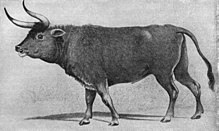
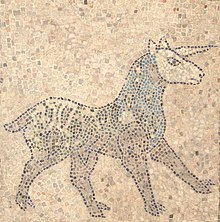
An animal called the re'em (Hebrew: רְאֵם) is mentioned in several places in the Hebrew Bible, often as a metaphor representing strength. The allusions to the re'em as a wild, untamable animal of great strength and agility, with mighty horn or horns[41] best fit the aurochs (Bos primigenius); this view is further supported by the Assyrian cognate word rimu, which is often used as a metaphor of strength, and is depicted as a powerful, fierce, wild mountain bull with large horns.[42] This animal was often depicted in ancient Mesopotamian art in profile, with only one horn visible.[43]
The translators of the
- "God brought them out of Egypt; he hath as it were the strength of an unicorn."—Numbers 23:22
- "God brought him forth out of Egypt; he hath as it were the strength of an unicorn."—Numbers 24:8
- "His glory is like the firstling of his bullock, and his horns are like the horns of unicorns: with them he shall push the people together to the ends of the earth."—Deuteronomy 33:17
- "Will the unicorn be willing to serve thee, or abide by thy crib? Canst thou bind the unicorn with his band in the furrow? or will he harrow the valleys after thee? Wilt thou trust him, because his strength is great? or wilt thou leave thy labour to him? Wilt thou believe him, that he will bring home thy seed, and gather it into thy barn?"—Job 39:9–12
- "Save me from the lion's mouth; for thou hast heard me from the horns of unicorns."—Psalms 22:21
- "He maketh them [the cedars of Lebanon] also to skip like a calf; Lebanon and Sirion like a young unicorn."—Psalms 29:6
- "But my horn shalt thou exalt like the horn of the unicorn: I shall be anointed with fresh oil."—Psalms 92:10
- "And the unicorns shall come down with them, and the bullocks with their bulls; and their land shall be soaked with blood, and their dust made fat with fatness."—Isaiah 34:7
The classical Jewish understanding of the Bible did not identify the Re'em animal as the unicorn. However, some rabbis in the
Chinese mythology
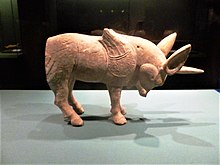
The
Beginning in the
See also
- Al-mi'raj(unicorn-like creature in Arabic mythology)
- Bestiary
- Elasmotherium (extinct rhinoceros species known as "Siberian unicorn")
- Invisible Pink Unicorn (a modern satirical religious symbol)
- *List of horses in mythology and folklore
- Monoceros(constellation)
- Okapi (real animal once known as "African unicorn")
- Sin-you (mythology)
- Synthetoceras (extinct protoceratid/prehistoric pronghorn species, once lived throughout Eurasia and North America)
- Winged unicorn
References
- ^ "Zampieri Domenico, Madonna e unicorno". Fondazione Federico Zeri, University of Bologna.
- ^ a b Phillips, Catherine Beatrice (1911). . In Chisholm, Hugh (ed.). Encyclopædia Britannica. Vol. 27 (11th ed.). Cambridge University Press. pp. 581–582.
- ^ "Cosmas Indicopleustis - Christiana Topographia (MPG 088 0051 0476) [0500-0600] Full Text at Documenta Catholica Omnia". www.documentacatholicaomnia.eu.
- ^ Unicorn, Merriam-Webster Dictionary.
- ISBN 9781598746860, Google Books
- ^ Ctesias. "45". Indica (Τα Ἰνδικά). Archived from the original on 2012-07-16. Retrieved 2020-03-26. (quoted by Photius)
- ISBN 9789380636467.
- ISBN 978-1617842818.
- ^ Aristotle. "Book 3. Chapter 2.". On the Parts of Animals (Περι ζώων μορίων). trans. William Ogle. Archived from the original on 2008-05-01.
- ^ Aristotle. "Book 2. Chapter 1.". History of Animals (Περί ζώων ιστορίας). trans. D'Arcy Wentworth Thompson. Archived from the original on 2007-06-30.
- ^ Antigonus, Compilation of Marvellous Accounts, 66
- ^ Strabo. "Book 15. Chapter 1. Section 56.". Geography.
- ^ Pliny. "Book 8, Chapter 31". Natural History. trans. John Bostock. Also Book 8, Chapter 30, and Book 11, Chapter 106.
- ^ Aelian (220) [circa]. "Book 3. Chapter 41.". On the Nature of Animals (Περὶ Ζῴων Ἰδιότητος, De natura animalium). trans. A.F.Scholfield.
- ^ Aelian (220) [circa]. "Book 4. Chapter 52.". On the Nature of Animals (Περὶ Ζῴων Ἰδιότητος, De natura animalium). trans. A.F.Scholfield.
- ^ Aelian (220) [circa]. "Book 16. Chapter 20.". On the Nature of Animals (Περὶ Ζῴων Ἰδιότητος, De natura animalium). trans. A.F.Scholfield.
- ^ Cosmas Indicopleustes. "Book 11. Chapter 7.". Christian Topography.
- ^ Manas: History and Politics, Indus Valley. Sscnet.ucla.edu. Retrieved on 2011-03-20.
- ^ נאור, עמית (2019-12-10). "Unicorns in the Holy Land?". The Librarians. Retrieved 2024-02-21.
- ^ ISBN 0719539714.
- ^ Marilyn Aronberg Lavin, 2002. Piero della Francesca, pp. 260–265.
- ISBN 978-1341338465.
- ISBN 978-0-7910-9394-8.
- ^ Browne, Thomas (1646). "Book 3. Chapter 23.". Pseudodoxia Epidemica.
- OCLC 4049353.
- ISBN 978-1-4375-0853-6.
- ^ "Universal Leonardo: Leonardo da Vinci online › Young woman seated in a landscape with a unicorn". www.universalleonardo.org.
- ^ "Ancient unicorn tapestries recreated at Stirling Castle". BBC News. 23 June 2015. Retrieved 11 June 2017.
- ISBN 0-85331-270-2, another image
- The Riverside Shakespeare, Second Edition, page 1515
- ^ ISBN 978-0-906670-44-6.
- ^ "Why is the Unicorn Scotland's national animal?". The Scotsman. 19 November 2015. Retrieved 14 April 2019.
- ^ Unicorn Of Scotland – Symbol of Power[1]
- ^ Nisbet, Alexander (1816). A System of Heraldry. Edinburgh: William Blackwood.
- ^ & tartans George Way, Romilly Squire; HarperCollins, 1995; page 84 "Cunningham CREST A unicorn's head couped Argent armed Or MOTTO 'Over fork over'
- ^ a b c d e "How did unicorns get so gay? An investigation". Mic. 24 June 2020. Retrieved 2022-08-15.
- ^ a b c Wareham, Jamie (2018-08-17). "Unicorns are the gay, LGBTI and queer icons of our time (and I'm obsessed)". Gay Star News. Archived from the original on 2022-03-02. Retrieved 2022-08-15.
- ^ a b c "Why the unicorn has become the emblem for our times | Alice Fisher". the Guardian. 2017-10-15. Retrieved 2022-08-15.
- ^ a b c d "How Did the Unicorn Become a Symbol of Queerness?". The Whale. 29 October 2021. Archived from the original on 2022-08-15. Retrieved 2022-08-15.
- ^ Iversen, Kristin (6 June 2017). "Why Millennials' Obsession With Mermaids, Unicorns, And The Color Pink Matters". Nylon. Retrieved 2022-08-15.
- Deuteronomy33:17; compare Psalms 112:11
- ^ Hirsch, Emil G.; Casanowicz, I. M. "Unicorn". Jewish Encyclopedia. Retrieved 26 October 2022.
- ^ "Unicorn". Britannica. Encyclopædia Britannica. 29 August 2022. Retrieved 26 October 2022.
- ^ Psalms 21:22, 28:6, 77:69, 91:11; Isaiah 34:7. The Latin rhinoceros is employed in Numbers 23:22, 24:8; Deuteronomy 33:17, Job 39:9–10
- ^ "Babylonian Talmud: Shabbath 28". halakhah.com.
- ^ Lair of King Tongmyong's Unicorn Reconfirmed in DPRK, Korean Central News Agency, November 29, 2012, archived from the original on December 3, 2012
- ^ Quinn, Ben. "Unicorn lair 'discovered' in North Korea". The Guardian. Retrieved 5 August 2013.
- ^ Wilson, Samuel M. (December 1992). "The Emperor's Giraffe". Natural History. 101 (12). Archived from the original on 2008-12-02. Retrieved 2012-04-14.
- ^ "此"麟"非彼"麟"专家称萨摩麟并非传说中麒麟". www.chinanews.com.
- ISBN 978-0-520-21844-4.
External links
- American Museum of Natural History, Mythic Creatures: Unicorns, West and East
- Pascal Gratz, De Monocerote – Zur Rezeptionsgeschichte des Einhorns (PDF, German)
- David Badke, The Medieval Bestiary: Unicorn
- Phillips, Catherine Beatrice (1911). . In Chisholm, Hugh (ed.). Encyclopædia Britannica. Vol. 27 (11th ed.). Cambridge University Press. pp. 581–582.









